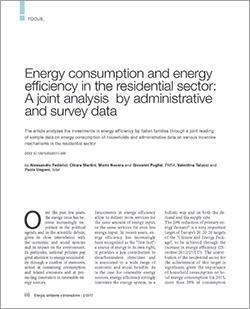
Energy consumption and energy efficiency in the residential sector: A joint analysis by administrative and survey data
by Alessandro Federici, Chiara Martini, Mario Nocera and Giovanni Puglisi, ENEA; Valentina Talucci and Paola Ungaro, Istat
DOI 10.12910/EAI2017-038
The article analyzes the investments in energy efficiency by Italian families through a joint reading of sample data on energy consumption of households and administrative data on various incentive mechanisms in the residential sector
Over the past few years, the energy issue has become increasingly important in the political agenda and in the scientific debate, given its close interrelation with the economic and social systems and its impact on the environment. In particular, national policies pay great attention to energy sustainability through a number of measures, aimed at containing consumption and related emissions and at promoting innovation in renewable energy sources.
Investments in energy efficiency allow to deliver more services for the same amount of energy input, or the same services for even less energy input. In recent years, energy efficiency has increasingly been recognized as the “first fuel”: a source of energy in its own right, it provides a key contribution to decarbonization objectives and is associated to a wide range of economic and social benefits. As is the case for renewable energy sources, energy efficiency strongly innovates the energy system, in a holistic way and on both the demand and the supply side.
The 20% reduction of primary energy demand is a very important target of Europe’s 20-20-20 targets of the “Climate and Energy Package”, to be achieved through the increase in energy efficiency (Directive 2012/27/EU). The contribution of the residential sector for the achievement of this target is significant, given the importance of household consumption on total energy consumption (in 2015, more than 28% of consumption in the EU-28, Http://www.eea.europa.eu). …

